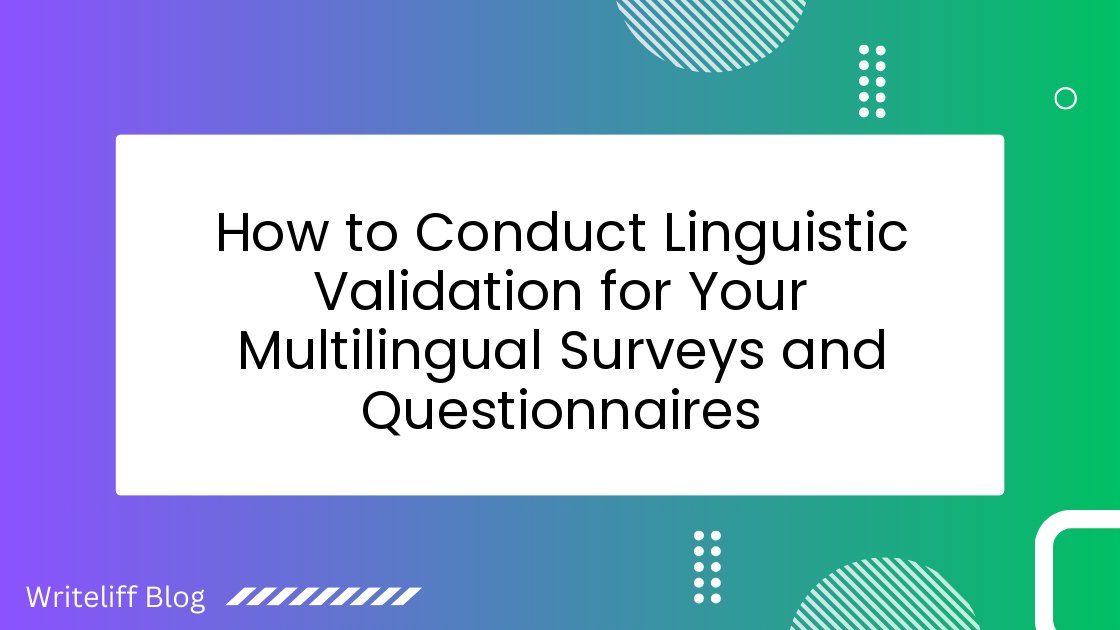How to Conduct Linguistic Validation for Your Multilingual Surveys and Questionnaires

As a researcher or business owner, you may need to create multilingual surveys and questionnaires to gather data from diverse populations. Ensuring the accuracy and cultural appropriateness of your translated materials is crucial for obtaining reliable results. One way to achieve this is by employing a professional translation service and conducting linguistic validation. In this blog post, I will guide you through the process of linguistic validation and provide tips on how to ensure the quality of your multilingual surveys and questionnaires.
Understanding Linguistic Validation
Linguistic validation is the process of verifying that a translated document, such as a survey or questionnaire, accurately conveys the intended meaning of the original text while maintaining cultural appropriateness. This process involves several steps, including:
- Forward translation: Translating the original document into the target language by a professional translator.
- Backward translation: Translating the forward-translated document back into the original language by a different translator to identify any discrepancies or inaccuracies.
- Reconciliation: Comparing the original document and the backward-translated document to resolve any discrepancies and ensure the accuracy of the translation.
- Cognitive debriefing: Testing the translated document with a sample of the target population to ensure that the content is clear, understandable, and culturally appropriate.
Selecting a Professional Translation Service
Choosing the right professional translation service is crucial for ensuring the quality of your multilingual surveys and questionnaires. Consider the following factors when selecting a translation service:
- Experience and expertise: Look for a translation service with a proven track record in your industry and experience in translating surveys and questionnaires.
- Quality assurance processes: Ensure that the translation service follows a rigorous quality assurance process, including linguistic validation, to guarantee the accuracy and cultural appropriateness of your translated materials.
- Native-speaking translators: Work with a translation service that employs native speakers of the target language to ensure the highest level of linguistic and cultural accuracy.
Preparing Your Survey or Questionnaire for Translation
Before submitting your survey or questionnaire for translation, take the following steps to ensure a smooth and efficient process:
- Review the original document: Ensure that your survey or questionnaire is clear, concise, and free of jargon or idiomatic expressions that may be difficult to translate.
- Provide context and background information: Offer the translation service any relevant information about your survey or questionnaire, such as the purpose, target audience, and any specific cultural considerations.
- Collaborate with the translation service: Maintain open communication with the translation service throughout the process to address any questions or concerns and ensure the best possible outcome.
Conducting Cognitive Debriefing
Cognitive debriefing is a crucial step in the linguistic validation process, as it helps ensure that your translated survey or questionnaire is clear, understandable, and culturally appropriate for the target population. To conduct cognitive debriefing:
- Select a representative sample: Choose a group of individuals from the target population who are representative of the demographic you wish to survey.
- Administer the translated survey or questionnaire: Have the participants complete the translated survey or questionnaire, noting any areas where they experience difficulty or confusion.
- Conduct interviews or focus groups: Gather feedback from the participants about their experience completing the survey or questionnaire, focusing on any areas of difficulty or confusion.
- Revise the translation as needed: Based on the feedback from the cognitive debriefing, work with the translation service to revise the translated survey or questionnaire as necessary to ensure clarity and cultural appropriateness.
Final Thoughts
Conducting linguistic validation for your multilingual surveys and questionnaires is essential for ensuring the accuracy and cultural appropriateness of your translated materials. By following the steps outlined in this blog post and working closely with a professional translation service, you can create high-quality, reliable surveys and questionnaires that effectively gather data from diverse populations.
